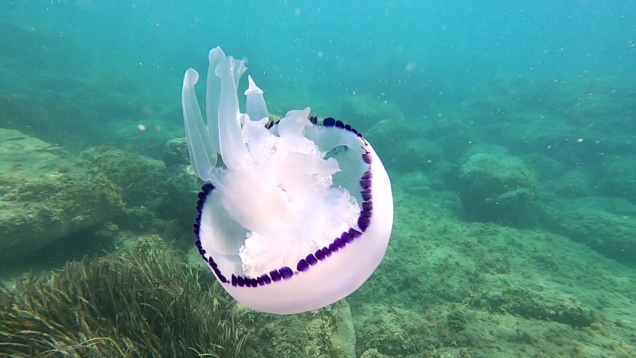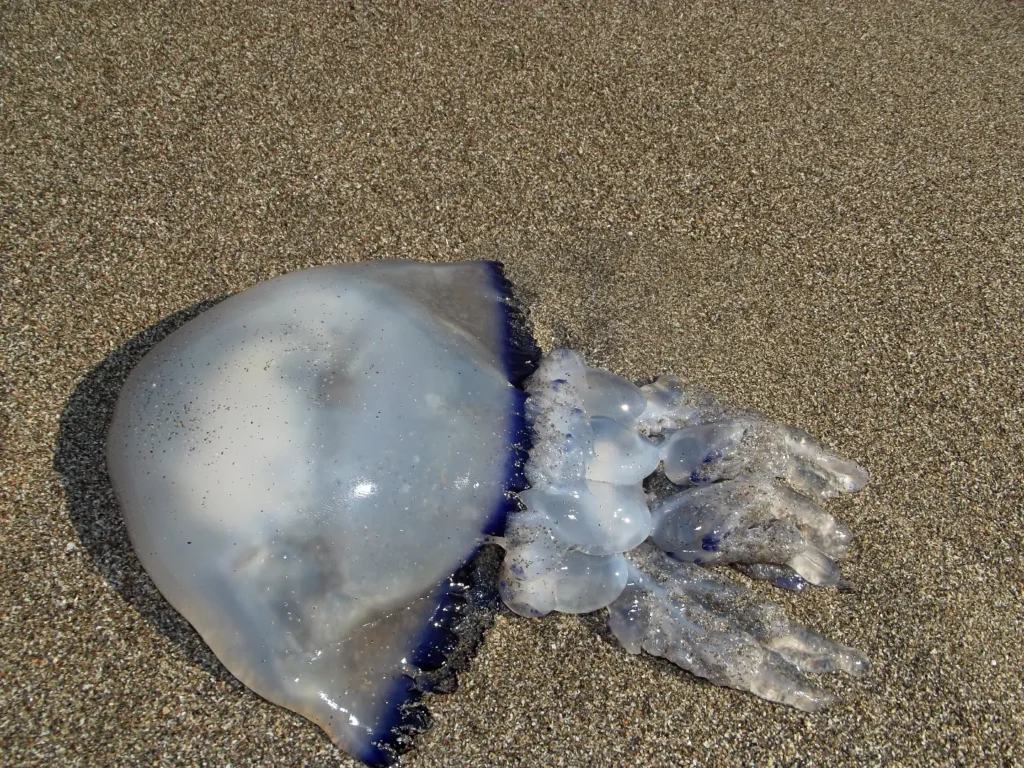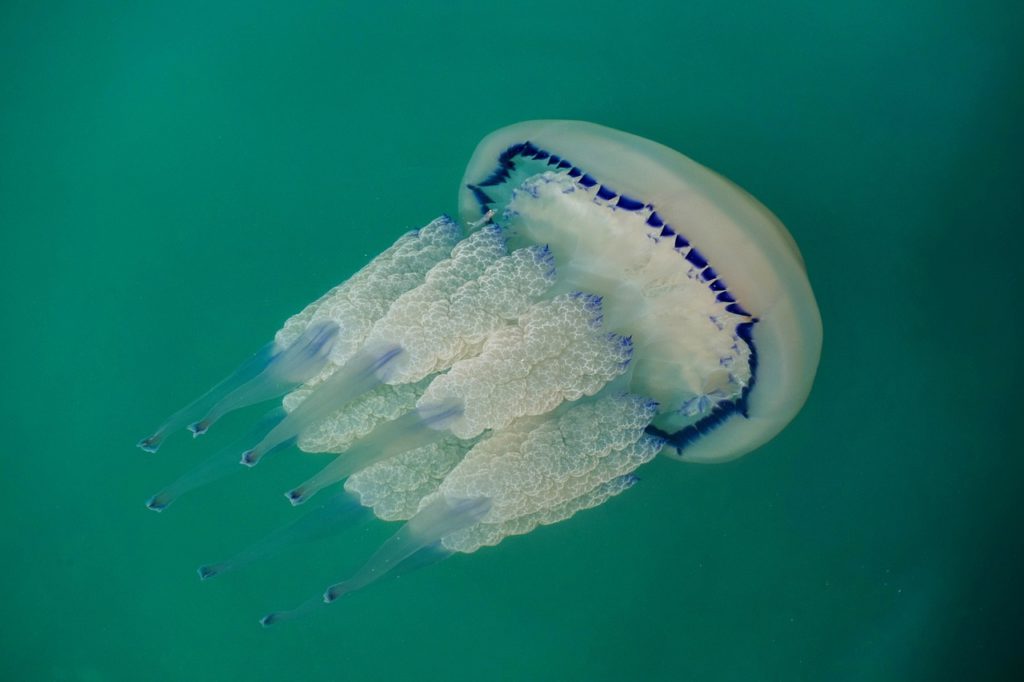Medusa kornerot (Rhizostoma pulmo)- one of the largest jellyfish in the Black and Mediterranean Seas. It impresses with its size, elegant movement and unusual body structure, which distinguishes it from other species. Despite its huge umbrella, the rooter it doesn't have the usual stinging tentacles, and its toxicity to humans moderate.

🔍 Main Features:
✔ Dome diameter-up to 90 cm
✔ Weight-up to 10 kg
✔ Transparent-white body with blue or purple edges
✔ Instead of long tentacles-8 fleshy mouth blades
✔ It lives in seas with temperate and warm climates
The root jellyfish plays an important role in the marine ecosystem, helping to regulate plankton populations, but can also create massive aggregations that affect fishing and tourism activities.
Scientific classification
🔬 Classification:
✔ The Kingdom: Animals (Animalia)
✔ Type: Cnidarians (Cnidaria)
✔ Class: Scyphoid (Scyphozoa)
✔ Row: Kornerotu (Rhizostomeae)
✔ Family: Rhizostomatidae
✔ Gender: Rhizostoma
✔ View: Rhizostoma pulmo
📌 Interesting!
The name "rootworm" comes from the structure of the oral apparatus-instead of the usual tentacles, this jellyfish has fleshy lobes that resemble lips.
Appearance and body structure
📏 Sizes:
• Dome diameter: 50-90 cm
• Weight: 5-10 kg
🎨 Color scheme:
• Transparent-white or bluish body
• The edges of the dome often have a purple or blue tint
🧬 Body type:
• Dome (bell) – smooth, without a hole in the middle
• No long stinging tentacles
• 8 mouth blades covered with fine hairs for catching food
💡 Why is rootworm different from other jellyfish?
Instead of tentacles, which use stinging cells to paralyze the victim, this jellyfish filters plankton by passing water through numerous channels in its mouth blades.
📌 Interesting!
Unlike most jellyfish, the rootworm moves more activelyby performing strong dome contractions.

Living environment
🌍 Where does the root jellyfish live?
• The Black Sea
• The Mediterranean Sea
• Atlantic Ocean (off the coast of Europe and Africa)
🌊 Environment Parameters:
• Water temperature-15-30°C
• Salinity-medium or high
• Prefers open sea areas, but often occurs off the coast
📌 Interesting!
In summer, due to mass reproduction, rootlets can form huge clusterswhich looks impressive.
Life cycle
🌀 How does the root jellyfish reproduce?
1️⃣ Sexually mature jellyfish (medusoid stage) throws eggs and sperm into the water.
2️⃣ Larva (planula) it floats in the water column until it attaches to the bottom.
3️⃣ Polyp it grows and lives for several months or even years.
4️⃣ Strobilation-polyp separation on a few tiny jellyfish (ether), which later become adults.
📌 Interesting!
If conditions become unfavorable, a polyp can wait for better conditions for yearsbefore you give a new generation of jellyfish!
Nutrition and lifestyle
🍽 What does the root jellyfish eat?
• Plankton (crustaceans, fish larvae)
• Microscopic algae
• Small invertebrate organisms
💡 How does it catch food?
Root root filters waterby passing it through the mouth blades, where nutrient particles are trapped.
📌 Interesting!
This jellyfish an important part of the food chainas it not only feeds on plankton, but also becomes prey for sea turtles, fish, and even some humans.

Is the root jellyfish dangerous for humans?
⚠ It can sting, but not fatally!
• Its toxins cause mild skin irritation
• Contact with the mouth blades can cause redness and itching
🚑 What should I do if I get bitten?
✔ Do not rub your skin!
✔ Wash the affected area with sea water (not fresh water!).
✔ Apply vinegar or lemon juice to neutralize the toxins
📌 Interesting!
Compared to other jellyfish (such as the crown jellyfish or irukandji), the rootworm it is much less dangerous.
Medusa rootworm and man
🏖 How does it affect tourists?
* During periods of mass reproduction may make bathing difficult
* Often becomes an object of curiosity for divers
🎣 Is it used in fishing?
* In some countries (such as China) rooters are eaten
* Used in cosmetology and pharmaceuticals (to create anti-aging creams)
📌 Interesting!
Jellyfish extracts are used in biomedical researchbecause they contain collagen and proteins that slow down aging.
Interesting facts
📌 Top 5 facts about the Kornerot Jellyfish:
1️⃣ One of the largest jellyfish in the Black Sea
2️⃣ Does not have poisonous tentacles-uses mouth blades
3️⃣ Its population depends on the water temperature and climatic conditions
4️⃣ It often creates massive accumulations, which affects fishing.
5️⃣ Edible-used in some Asian countries
Conclusion
Medusa kornerot – amazing creaturewhich is an important part of the marine ecosystem. She graceful, large and not too dangerous for humans. At the same time, its massive accumulations can affect the tourism industry and fishing.
🌊 Studying these jellyfish helps us better understand the ocean and its ecosystems!
